Mode(s) 1 Player Genre Shoot 'em up | Initial release date 17 October 1987 | |
 | ||
Composer(s) Tokuhiko UwaboSystem 16 remakeManabu Namiki Release date(s) Sega Mark III/Master SystemJP: October 17, 1987NA: December 31, 1987EU: January 29, 1990ArcadeSega Mark III/Master System versionJP: February 1988System 16 remakeJP: 2008Family ComputerJP: December 20, 1988MSXJP: 1989WiiVirtual ConsoleJP: January 13, 2009PAL: May 8, 2009NA: June 29, 2009Nintendo 3DSSystem 16 remakeJP: July 16, 2014NA: April 16, 2015EU: April 16, 2015AU: July 2, 2015 Platforms Similar M2 games, Shoot 'em up games | ||
Fantasy zone ii the tears of opa opa for arcade mame
Fantasy Zone II: The Tears of Opa-Opa (ファンタジーゾーンII オパオパの涙, Fantajī Zōn tsū: Opa-Opa no Namida) is a Sega Master System game created by Sega in 1987. It was later ported to the arcade, Famicom, and MSX, and was remade for the System 16 hardware on a PlayStation 2 compilation in 2008. It was re-released on the Wii Virtual Console in North America on June 29, 2009. Like the first Fantasy Zone, the player controls a sentient spaceship named Opa-opa who fights surreal invader enemies. Like its predecessor, Fantasy Zone II departs from the traditional scrolling shooter themes with its bright colors and whimsical designs. For this reason, it is occasionally dubbed a "cute 'em up".
Contents

Plot

In the past, the courageous hero Opa-Opa saved the Fantasy Zone from the invading Nenon forces, but his victory came at a price as he was forced to fight his own father who led the invasion. It is now Space Year 1432, 10 years after that battle, and the Nenon forces are once again spreading chaos through the Fantasy Zone. Opa-Opa must once again fly into the Fantasy Zone to rout the invasion.

At the end of the game, Opa-Opa comes face-to-face with the invasion's mastermind: an identical copy of himself. After a tense battle, Opa-Opa's father appears to confront them, and the sight of him brings Opa-Opa to tears which causes the second Opa-Opa to vanish. It is later revealed that this twin is a physical manifestation of Opa-Opa's dark impulses and desires, spawned from his prior battles and seeking to drive the Fantasy Zone into ruin. Reunited with his father, Opa-Opa is able to purge this darkness from himself and swears that such a disaster will never occur again.
Gameplay

Similar to Defender, the player occupies a side-scrolling level that repeats indefinitely, and in which the player can freely travel left or right. Each zone contains several "bases" that serve as primary targets. New to the sequel are "warps" hidden behind certain bases that allow the player to travel between different zones. Each level has at least three zones, and when all of the bases have been cleared in all of the zones of a level, the player can travel through the warp to the boss.

Boss fights do not allow for free travel as the main stages do, and force the player to face the boss or face a particular direction. Bosses are generally very large and change color to reflect damage taken. The final stage is a "boss rush" in which the player must fight a succession of previous bosses before fighting the final boss.

There are two action buttons that correspond to two types of attacks, "fire" and "bomb". The fire attacks shoot horizontally, as in a typical shooter, and different variants can be purchased at shops. The bomb attacks are more powerful, and the basic bomb drops downward. Other variants have other behaviors and are limited in quantity.
Shops, uncovered at key points, allow the player to purchase upgraded weapons, bombs, and speed, as well as extra lives. Upgrades to Opa-Opa's speed (such as larger wings, or jet engines) are permanent as long as the player does not lose a life, but weapon upgrades are time-limited, and bombs limited in quantity. Items become increasingly expensive with subsequent purchases, encouraging the player to vary their purchases.
Ports
The arcade version of Fantasy Zone II is based on the System E board, and as a result, is almost identical to the Master System version. Differences include the use of the radar that shows which bases are destroyed or not, as well as the use of a timer that, when it reaches zero, the player will lose a life. If the player manages to clear a level, the timer's remaining seconds will add to the score and money.
Unlike the original version, the Famicom port's subtitle on the title screen says The Teardrop of Opa-opa.
System 16 remake
In September 2008, Sega released a remake of Fantasy Zone II, included on the compilation Sega Ages Vol. 33 Fantasy Zone Complete Collection. Developed by M2, the game is not an attempt to modernize an older work like most remakes, but rather a hypothetical interpretation of what the game might have been like, had it been developed for System 16 arcade hardware by the original staff, rather than by Sega's console R&D for the Sega Master System and System E boards. It has been described as a "What If" remake, and strictly adheres to the technical limitations of the time in which Fantasy Zone II was originally released.
For the sake of authenticity, M2 developed the title on real System 16 hardware (albeit with a memory configuration expanded to 256KB, which M2 dubbed System 16C), and is playable in the compilation via emulation. It shows a 1987 SEGA copyright, makes no mention of M2, and bears no titular distinction from the original game. Because of this it can be easily confused for a real arcade title from 1987. Fans have dubbed this version Fantasy Zone II DX to distinguish it from the original versions.
It follows the original Fantasy Zone II only very loosely, pulling enemies, music, locations, and gameplay elements from the Master System game and pairing them with completely new content and elements of the original arcade Fantasy Zone. The most notable change is to the level structure. Rather than having several distinct zones in each stage that must be cleared, each stage in the remake has two parallel dimensions (Bright Side and Dark Side) of comparable size to the levels in the first Fantasy Zone. Bases destroyed in one dimension will also be destroyed in the other, making it possible to clear the level entirely on one side or the other. The Dark Side is more difficult, but offers greater rewards in points and money earned. Bosses are the same on either side, but have considerably more difficult attack patterns on the dark side. The game also features three endings, which depend on both whether the Dark Side levels were cleared and whether some specific items were bought.
The music, arranged by Manabu Namiki, uses melodies of many songs from Tokuhiko Uwabo's original Fantasy Zone II soundtrack, but is calculatedly rearranged in a style more similar to that of the original Fantasy Zone's composer, Hiroshi Kawaguchi. Namiki also wrote original tracks for the game. Stages and enemies are largely based on themes from the original, but some are difficult to recognize. Only about half of the game's bosses correspond to those in the original. It is generally regarded as very loose interpretation of the original.
M2 released a free demo of their version of Fantasy Zone II on their website that lets you download and play the first and second levels on a Windows computer.
The game was bootlegged and released to the arcades under the title FZ-2006 II by Taiwanese manufacturer ISG. The bootleg bears a 2006 copyright date but actually appears to be derived from the 2008 PlayStation 2 release due to it containing the same "2008-07-15VER" string embedded in the ROM data. Sega also produced a limited number of arcade units running real System 16 hardware to promote the game's release.
A Nintendo 3DS port of this 16-bit version of Fantasy Zone II was released in Japan in 2014 and internationally in 2015. Titled 3D Fantasy Zone II W, it includes new features, content, and a second game mode called Link Loop Land, an endless survival mode starring Opa-Opa's brother, Upa-Upa.
